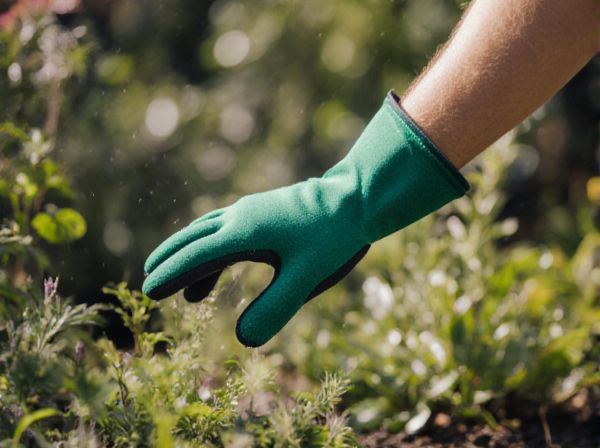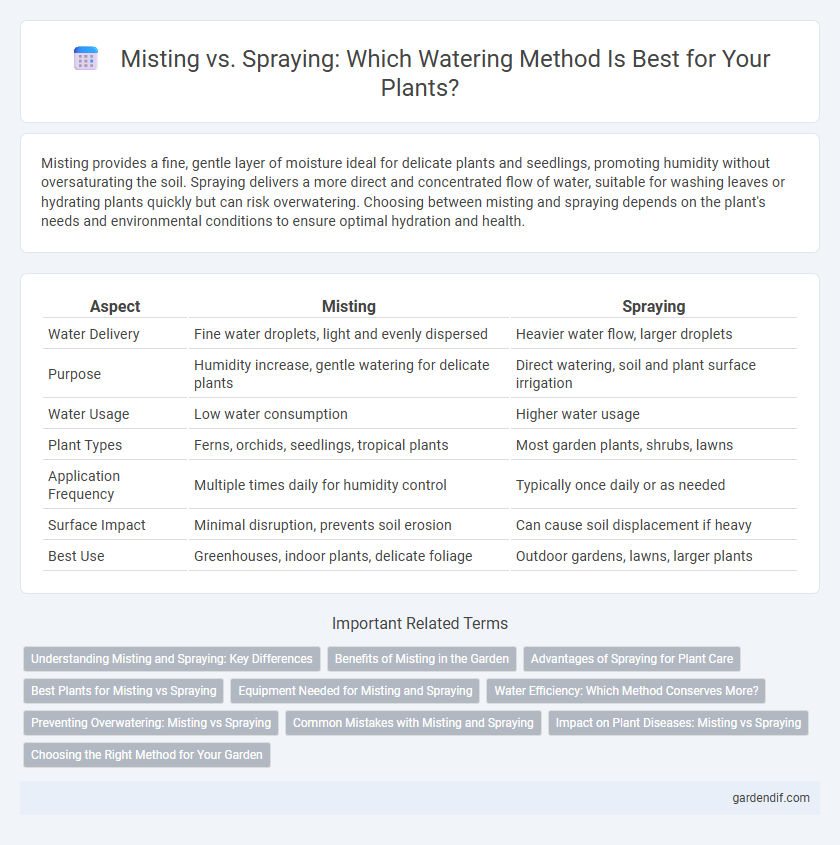
Misting vs Spraying Illustration
Misting provides a fine, gentle layer of moisture ideal for delicate plants and seedlings, promoting humidity without oversaturating the soil. Spraying delivers a more direct and concentrated flow of water, suitable for washing leaves or hydrating plants quickly but can risk overwatering. Choosing between misting and spraying depends on the plant's needs and environmental conditions to ensure optimal hydration and health.
Table of Comparison
| Aspect | Misting | Spraying |
|---|---|---|
| Water Delivery | Fine water droplets, light and evenly dispersed | Heavier water flow, larger droplets |
| Purpose | Humidity increase, gentle watering for delicate plants | Direct watering, soil and plant surface irrigation |
| Water Usage | Low water consumption | Higher water usage |
| Plant Types | Ferns, orchids, seedlings, tropical plants | Most garden plants, shrubs, lawns |
| Application Frequency | Multiple times daily for humidity control | Typically once daily or as needed |
| Surface Impact | Minimal disruption, prevents soil erosion | Can cause soil displacement if heavy |
| Best Use | Greenhouses, indoor plants, delicate foliage | Outdoor gardens, lawns, larger plants |
Understanding Misting and Spraying: Key Differences
Misting delivers a fine, gentle spray of water droplets that increase humidity and lightly moisten plant leaves without saturating the soil, ideal for delicate plants and seedlings. Spraying, by contrast, uses a stronger flow of water droplets to thoroughly wet foliage and soil, which is better suited for regular watering and cleaning. Understanding the water pressure, droplet size, and intended plant needs helps in choosing between misting and spraying for optimal hydration and plant health.
Benefits of Misting in the Garden
Misting in the garden provides gentle hydration that reduces water runoff and soil erosion, promoting healthier plant roots. This method increases humidity around delicate plants, which is especially beneficial for tropical and moisture-loving species. Misting also minimizes water waste by delivering fine droplets directly to the foliage, ensuring efficient water use and preventing fungal diseases caused by excessive moisture.
Advantages of Spraying for Plant Care
Spraying delivers larger water droplets that penetrate soil more effectively, promoting deeper root hydration and reducing water runoff. It provides thorough coverage that helps wash away dust and pests from plant leaves, enhancing photosynthesis and overall plant health. Spraying is particularly advantageous for robust watering needs requiring efficient moisture distribution and plant cleaning.
Best Plants for Misting vs Spraying
Misting is ideal for humidity-loving plants such as ferns, orchids, and African violets, which benefit from a fine, gentle moisture layer without waterlogging the soil. Spraying suits hardy plants like succulents, cacti, and certain tropical species that tolerate heavier water droplets and occasional soaking. Understanding plant-specific water requirements ensures optimal hydration and prevents issues like mold or root rot.
Equipment Needed for Misting and Spraying
Misting requires specialized equipment such as a fine nozzle or misting system connected to a water source that delivers a gentle, uniform spray of tiny water droplets, often powered by low-pressure pumps. Spraying uses standard spray bottles or garden sprayers capable of producing a broader, coarser water distribution, which can be powered manually or by motorized compression. Both methods depend on the correct equipment to ensure efficient water application tailored to the needs of plants or surfaces.
Water Efficiency: Which Method Conserves More?
Misting uses fine water droplets that reduce runoff and evaporation, making it more water-efficient for delicate plants and indoor gardening. Spraying delivers larger droplets, which can lead to faster soil saturation but higher water waste through runoff and evaporation. Choosing misting over spraying conserves more water, especially in arid environments or when watering fragile vegetation.
Preventing Overwatering: Misting vs Spraying
Misting delivers a fine, gentle layer of water that helps maintain humidity without saturating the soil, effectively preventing overwatering and root rot in sensitive plants. Spraying applies larger droplets that can quickly saturate soil and foliage, increasing the risk of excess moisture and fungal diseases. Choosing misting over spraying ensures optimal hydration by balancing moisture levels and promoting healthier plant growth.
Common Mistakes with Misting and Spraying
Common mistakes with misting include over-wetting foliage, which can lead to fungal diseases and mold growth, while spraying often suffers from uneven water distribution, causing some plants to receive too much water and others too little. Using hard water in both misting and spraying can leave mineral deposits on leaves, impairing photosynthesis and plant health. Frequent misting without considering humidity levels can create a persistently damp environment, increasing the risk of pest infestations like spider mites.
Impact on Plant Diseases: Misting vs Spraying
Misting creates a fine, consistent moisture layer that reduces leaf wetness duration, lowering the risk of fungal diseases such as powdery mildew. Spraying delivers larger water droplets that can cause leaf runoff and create humid microenvironments, potentially increasing disease incidence. Choosing misting over spraying minimizes pathogen proliferation by maintaining optimal leaf surface conditions.
Choosing the Right Method for Your Garden
Selecting between misting and spraying depends largely on plant types and environmental conditions; misting provides gentle hydration ideal for delicate seedlings and humidity-loving plants, while spraying offers more robust watering suitable for mature plants and larger foliage. Factors such as water pressure, droplet size, and frequency influence plant health and soil moisture levels, making it essential to tailor the method to specific garden needs. Efficient watering techniques maximize water conservation and promote optimal growth by preventing overwatering and minimizing runoff.
Misting vs Spraying Infographic

 gardendif.com
gardendif.com